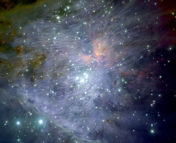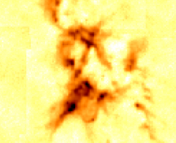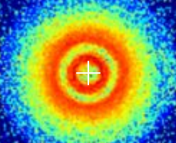Title: ALMA’s Polarized View of 10 Protostars in the Perseus Molecular Cloud
Authors: Erin G. Cox, Robert J. Harris, Leslie W. Looney, Zhi-Yun Li, Haifeng Yang, John J. Tobin, Ian Stephens
First Author’s Institution: University of Illinois at Urbana-Champaign
Status: accepted to Astrophysical Journal, open access on arXiv
Your Protostar Has Been Delivered
Protostars are not quite stars– they have not finished collapsing from a molecular cloud into a hydrogen-burning star. They are, however, a very interesting stage in a star’s life. Protostars are accreting material, building their mass so that at some point they have enough gravitational energy to begin to fuse hydrogen into helium. Protostars gather more mass as material gets pulled in from their outer envelope. The gas and dust gets sucked in by gravity and forms a rotating disk around the protostar, from which it both grows and sometimes ejects material in an outflow. Figure 1 shows the structure of a protostar from Tobin et al 2012.
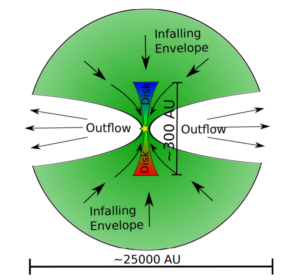
Figure 1. Cartoon of a protostellar system from Tobin et al. 2012. Protostars have an infalling envelope of less dense material and a rotating accretion disk of denser material closer in. They also have outflows of ejected material. The blue and red colors of the disk represent the Doppler shift that comes as a result of disk rotation.
Protostars are an important phenomenon to study because they help us understand the conditions occurring during star formation. Today’s paper analyzes the magnetic field and dust properties in 10 protostars.
Grab the Letter Opener
The author’s of today’s paper used measurements from the Atacama Large Millimeter Array (ALMA). They looked at the continuum emission around the protostars that stems from the thermal radiation of dust at 870 microns. They also made polarization measurements across the disks and envelopes of the protostars, as it can provide information about magnetic fields and the size of the dust.
Polarization arises because interstellar dust emits more light along one of its axes than the other. Dust is often elliptical in shape (think like a football or an egg) and is present in the envelope and disk of protostars, as well as many other astronomical environments. Interstellar dust tends to align its long axis perpendicular to a magnetic field. Because there is then more surface area perpendicular to the magnetic field, the dust emits more radiation in that direction. The difference in radiation in each direction provides a polarization magnitude and angle.
Reading the Letter
Today’s authors found well-ordered polarization inside the disk components of the protostars. In general, the disk polarizations were all in the same direction and had a relatively small magnitude. The disk polarization can be seen as the center component of the protostars in Figure 2. The black vectors represent polarization direction, and their length represents its magnitude. The figure clearly shows that the polarization in the central disk component (the brightest and therefore reddest part of the images) is small and uniform.
The envelope component of the protostars is quite the opposite- it appears more complex and disordered. Polarization (and therefore the inferred magnetic field) seems to vary with the structure of the protostar’s envelope. The magnitude of polarization is also much higher than that in the disks. These aspects are also shown in Figure 2 in the more extended regions of the protostars, where the flux is lower and the image fades to the blue region of the scale.
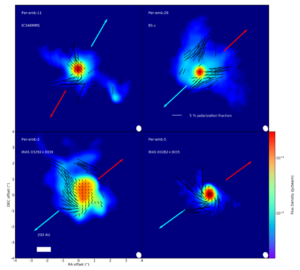
Figure 2. Dust continuum maps for four protostars. Color represents flux, with red as the brightest point of the protostar and decreasing flux outward from there. The blue and red arrows show the direction of outflow from the protostar. Polarization vectors (rotated by 90 degrees to represent the presumed magnetic field) are overlaid in black. The length of the polarization vectors shows the percent polarization. Notice how the outer envelopes of the protostars have larger polarizations than the inner regions/disks.
The envelope of the protostars seems to be consistent with elliptical dust (back to our football analogy) aligned perpendicular to the magnetic field. However, the polarization hole – as the authors call it – at the center of the protostars might result from different dust grain alignment mechanisms in the envelope and the disk of the protostars. Polarization in the disk might be lower because the magnetic field is tangled up, cancelling out some of what we would expect to see. Small dust grains are generally easier to align with a magnetic field, so today’s authors also suggest that the protostar disks may have larger dust grains than the dust in their envelopes. This would also make the dust grains more likely to scatter their own light, which may reduce the polarization.
Today’s paper demonstrates that the structure and properties of protostars vary as you move through their disks and envelopes. By providing a clearer picture of the composition of protostars, this result will hopefully allow us to turn a new page on our understanding of the star formation process.

